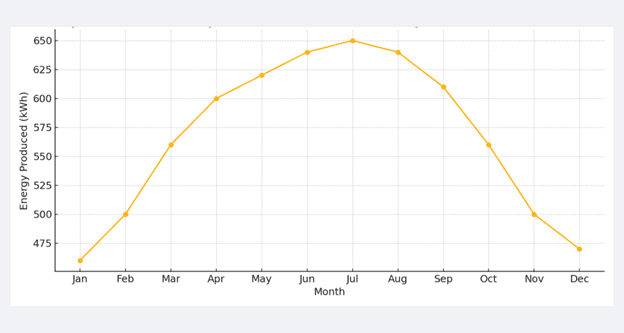
We need to understand with solar power how seasonal changes will dictate its level of performance to an extent. Though solar is effective throughout the whole year, there are some changes based on the season that we would like to make you aware of in this article.
How Do Seasonal Changes Affect Sunlight Intake For Your Solar Panels?
There are a variety of small ways in which the given season can affect how much sun your panels are actually absorbing, so let’s lay them out.
- Solar Angle
In the winter, the sun is lower in the sky due to the tilt of Earth’s axis. This means that a greater percentage of the sunlight will bounce off of the solar panels in the winter rather than hitting them straight on from nearly right above, like they would in the summer.
- Day Length
Furthermore, the winter days are also shorter than they are during all of the other seasons. This will result in less sun being drawn in by your panels during winter months.
- Cloud Cover
There are also certain seasons that tend to have more cloud cover. Winter takes the cake because colder air tends to fall towards the surface where we are and warmer air tends to rise, creating more moisture/clouds. For New England, spring falls behind it in second place, with the months of March and April having overcast skies around 66% of the time. This gloomy weather can also mean that less sunlight reaches your solar panels.
- Snow Cover
In the winter, fallen snow can cover the solar panels and make it so that little to no sunlight can reach them.
Beyond that, the whiteness of the snow also makes it have a high albedo, which means it’s more likely to reflect the sun’s light, therefore sending it away from the solar panels. The result of these two factors equates to less solar intake in the winter.
What Does This Mean For Your Solar Energy Production In Each Season?
Since these climate-related variables have a slight impact on the amount of light reaching the panels, each season of the year is naturally going to yield varying amounts of solar production. These changes are something to keep in mind, but, truly, not that drastic.
Summer
The summer is the time where your solar production is at its maximum. The combination of the longer days along with the higher sun angles allow for your panels to absorb more sunlight and produce more energy.
However, it is important to note that, when temperatures rise higher and higher above the threshold of 77℉, the efficiency of your solar panels decrease. Essentially, excessive heat leads to your output power declining for every degree warmer it gets. This is measured by the solar temperature coefficient. Though not that extreme, excessive heat can have small effects on your solar panel system, so it’s still important to monitor production even in the summer months.
Fall
The fall is still a relatively high period of production for your solar system. The days are starting to get shorter and the sun’s angle is starting to get lower, but the transition is gradual and days are often still pretty sunny. You will definitely have less energy production than you did in the summer, but not by a lot. Fall is a good time to monitor your system’s performance so that you can bear witness to the gray area in between summer and winter.
Winter
Winter solar production is naturally going to be lowest. The shorter days combined with the low angle of the sun allows accounts for this slight discrepancy. The cloudier skies and potential for snow can also play into that drop-off as well.
Despite this, your panels can still generate decent amounts of electricity. This is in part because, as mentioned before, since solar panels don’t work as efficiently in hot temperatures, they actually work more efficiently in colder temperatures. Furthermore, the snow factor doesn’t end up playing a huge role because many solar panels are designed to shed off/absorb snow cover.
Regardless, it’s definitely a good idea to monitor your solar system yourself in the winter, just in case there is excessive snow that might be too much for the shedding feature to handle.
Spring
Spring is an improvement from winter in terms of solar production but not quite at the level of summer and fall, especially since many days are still rainy/overcast. However, the rising angle of the sun gives your system that slight boost in electricity generation. During the spring, it’s always good to check up on your panels and make sure they are fully recovered from the winter so that they are ready to go for the peak summer months.
How Do I Optimize My Solar Production In The “Off-Season”?
In the “off-season” of winter, when your solar production is relatively low, investing in a solar battery storage system can be extremely convenient. When battery storage is part of your solar system, it allows you to store excess energy from especially sunny days and then utilize it later during periods when electricity generation is low. A great example for when your battery storage could come in handy would be during these winter months when energy demands are higher but sunlight availability is lower.
Furthermore, net metering can allow you to earn credits for that excess energy you produced earlier in the year, which you can then use to pay for additional electricity that you might need in the winter due to low solar production.
Invest In Solar Battery Storage Today
Here at Solaris Renewables, we offer battery storage that you can use to give a helping hand to your solar production during the winter months. If you are interested in purchasing a SolarEdge StorEdge Battery or a Tesla Powerwall, please contact us today for a quote!